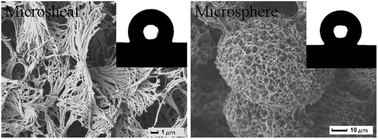3D porous poly(l-lactic acid) foams composed of nanofibers, nanofibrous microsheaves and microspheres and their application in oil–water separation
Abstract
Morphology transition from nanofibers to nanofibrous microsheaves to nanofibrous microspheres was reported for poly(L-lactic acid) (PLLA) induced by thermally induced phase separation of PLLA/dimethylformamide solution. It was found that nanofibrous microspheres, microsheaves, and nanofibers were produced from solutions with a PLLA concentration of over 5 wt%, 3 wt%, and 1 wt%, respectively. With respect to the effect of quenching temperature, microspheres and microsheaves were formed at a Tq of −10 °C and −20 to −50 °C, respectively. The mechanism of nucleation and crystal growth is responsible for the formation of various PLLA nano-/micro-structures. The foams composed of nanofibers, microsheaves, and microspheres were highly porous in three dimensions with a porosity of over 90%. The nano-/micro-dual-scale structure on the foam surface and the trapped air in pores significantly improved the foams' water contact angle to up to 134°, compared to 79° of the solvent-cast PLLA monolithic film. Due to hydrophobicity, large pore volume and high capillary effect, the oil absorption ratio of PLLA porous foams reached up to 1900%. Additionally, such foams absorbed oil in preference to water in an oil–water mixture. In combination with the biodegradable character, these PLLA foams are potential environmentally benign oil absorbents and oil–water separation materials.


 Please wait while we load your content...
Please wait while we load your content...